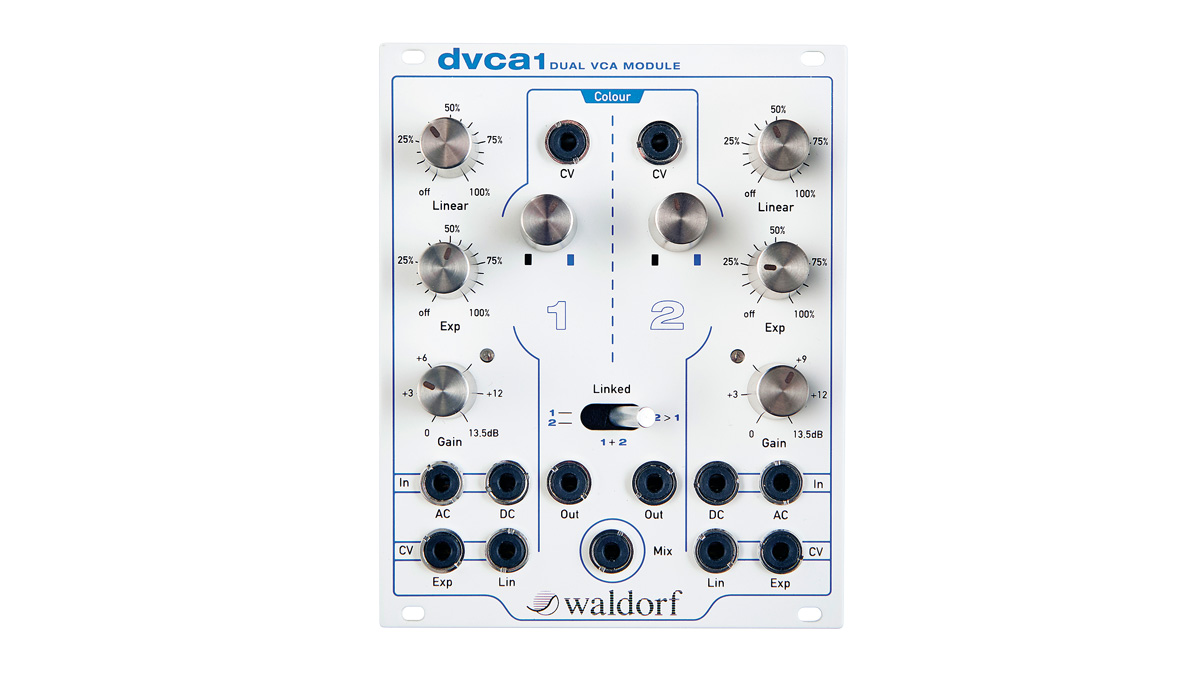MusicRadar Verdict
A fully-featured Dual VCA which sounds great. The module is well laid out with plenty of sound/CV shaping potential.
Pros
- +
A very well laid out panel – ergonomic with plenty of space.
- +
Sounds great.
Cons
- -
This is a big module - the high HP may put off the space-conscious user.
MusicRadar's got your back
The DVCA1 joins Waldorf’s Oscillator, Compressor and Modulation modules to complete the company’s Eurorack synth voice: which fits neatly into their KB37 Case & Controller Keyboard.
Following recent trends in Eurorack, this is a dual VCA; each VCA circuit can be used separately, together through a separate mixed output or for processing in stereo including panning effects.
Each side features separate inputs for AC (usually audio) and DC (usually CV), the AC input features what Waldorf call a ‘Colour control’. What this means in practice is a 2 pole OTA filter. Fully left the filter is completely open; as you turn the knob clockwise the filter cutoff frequency is reduced in parallel to the contour of the VCA adding warmth and colour to the timbre. The result sounds like a traditional low-pass gate but without using a vactrol.
The VCAs themselves are very clean and detailed and sound great.
You also have an extra Gain control which can add up to 13.5dB to bump up low input levels or to add clipping distortion (indicated by a red LED) if you want an extra bit of filth.
The VCAs themselves are very clean and detailed and sound great. It does seem a shame that the Gain control sits after the filter so it simply scales the level of the VCA and any applied modulation. We would have preferred initial gain amplification so that you could push the signal hard initially and then filter it back.
Both Exponential and Linear CV inputs are offered, each with an attenuator. Traditionally Exp would be used for Audio and Lin for CV, as Exponential signals follow the decibel scale like human hearing while Linear simply multiplies the amplification of the input signal with the amount of CV signal. The Exponential input produces sharper, snappier modulations than the Linear input.
Having both inputs rather than a switch gives you more scope for experimentation. Ultimately it’s a matter of taste - if it sounds good to you, do it! We had fun using both at the same time: feeding an envelope into the Exp input for overall level control with an LFO into the Lin input for a touch of tremolo.
Having both inputs rather than a switch gives you more scope for experimentation. Ultimately it’s a matter of taste - if it sounds good to you, do it!
At the bottom of the module is a three-position switch that controls how the two sides work together.
Independent mode lets the two VCAs act separately. Parallel mode is used when you want to control a stereo signal; the controls of the right VCA are disabled and the left controls are used for both channels. In Anti-parallel mode the linear CV control for the right channel is disabled and the right responds to the left CV input but inverted, so you can use an LFO for auto panning between the channels for anything from subtle sweeps to crazy Audio-rate modulations.
VCAs are very flexible devices and as the saying goes you can never have too many. Having two linked in one module certainly has some advantages. With the Audio input as the Carrier signal and another Audio source into the CV as the Modulator you can produce AM or Amplitude Modulation to get similar sounds to a Ring Mod – great for metallic timbres. Check Frank Murder’s ‘Why Can I Never Have Enough VCAs?’ YouTube series for more ideas.
“It’s about delivering the most in-demand mods straight from the factory”: Fender hot-rods itself as the Player II Modified Series rolls out the upgrades – and it got IDLES to demo them
“For some reason, the post office shipped your guitar to Jim Root of Slipknot”: Sweetwater mailed a metal fan's Jackson guitar to a metal legend
"No one phoned me. They never contacted me and I thought, 'Well, I'm not going to bother contacting them either'": Ex-Judas Priest drummer Les Binks has died aged 73










